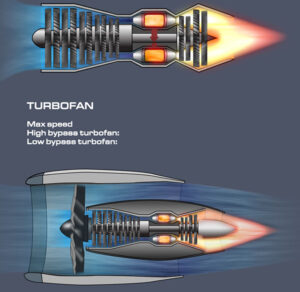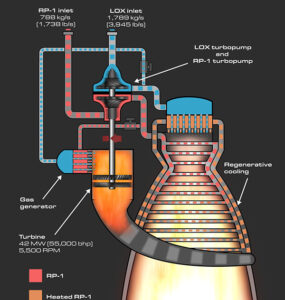Kawasaki H2R Race Motorcycle - 243 kW
For two wheels, the Kawasaki H2R is the engine power benchmark. With 243 kW (326 hp) at the back wheel, it’s the most powerful mainstream production bike on the planet. The H2R is for track use only and is 50% more powerful than the street legal version.
The H2R’s crazy amount of power comes from a supercharged 998cc four-stroke engine. And at a weight of only 216kg, the H2R has a power to weight ratio of 1.13 kW/kg, which is higher than the fastest production cars on the planet.
In 2016, Supersport racer Kenan Sofuoglu set out to push the limits of the H2R across the Osman Gazi Bridge in Turkey. In just 26 seconds, Sofuoglu’s H2R registered 400 km/h (249 mph)!
Volvo FH 16 750 Semi Truck - 559 kW
Hauling heavy loads requires power, and with 559 kW (750 hp), no production semi has more than the Volvo FH16 750.
The FH16 750’s 16 litre engine is around 7 times larger than an average car engine. Alongside its amazing power also comes 3,550 Nm (2,618 ft-lb) of torque, which allows it to pull loads of up to 325 tonnes!
Koenigsegg Gemera Sports Car - 1,715 kW
While not as fast as the Koeniggsegg Agara, the V8 version of the Gemera topped the list for production car power in 2023. Its twin-turbo 5 litre hybrid engine produces a staggering 1,715 kW (2,300 hp) of power!
The Gamera has a top speed of 400 km/h (248 mph) and does 0-100km/h in just 1.9 seconds. In full electric mode, the Gamera’s top speed is slower, but still a very respectable 300km/h (186 mph).
The mantle of the most powerful production car is hotly contested. We will probably see a new leader overtake the Gemera soon. In particular, the high performance electric cars coming onto the market have the potential to raise the bar even further.
PRR Q2 Steam Engine - 5,056 kW
You may wonder, what’s a mid-20th century steam engine doing on this list? Believe it or not, steam engines were more powerful than modern day diesel electric engines. And the Pennsylvania Railroad class Q2 (PRR Q2 for short) was the biggest beast of them of all, with 5,956 kW (7,987 hp) of output.
Being a steam engine, combustion external to the engine provides the thermal energy. This is in contrast to car engines and pretty much every other vehicle engine used today, which are internal combustion engines.
The PRR Q2 could pull 125 freight cars at a speed of 80km/h (50 mph), making it integral to America’s industry in the 20th century. It’s high operational and maintenance costs, however, put it out of action by the early 1950s. Sadly, all twenty-five PRR Q2 engines that once operated were sent to scrap, leaving us not much more than black-and-white photos to revel in their engineering.
Top Fuel dragster - 8,241 kW
As conventional dynos cannot test dragsters, the exact engine power of Top Fuel dragsters was the subject of speculation. Then, AVL Racing developed a torque sensor that could measure dragster power in real time. And the numbers they saw surprised everyone. Team US Army’s peak power came to 8,241 kW (11,051 hp)!
Top Fuel dragsters are the fastest racing cars in the world. They have top speeds of up to 544km/h (338 mph) and can reach 161km/h in 0.8 seconds. With this comes some serious g-forces of up to 5.6g.
Top Fuel dragster engines are even more amazing when considering the heavy design limits imposed on them. Aspects of them use decades old tech. However, the saying “there’s no replacement for displacement”, rings true here, with their large 8.19 litre supercharged engines making up for any lack of modern advancement.
Rolls-Royce UltraFan Airliner Engine - 64,000 kW
The Rolls-Royce UltraFan is the next generation of airliner jet engine. To become the world’s most efficient, it has also become the most powerful. Rig tests have seen 64,000kW (85,825 hp) at the UltraFan’s gearbox, which is an aerospace record.
Like most other jet engines in use today, the UltraFan is a turbofan. As opposed to a turbojet which has all gasses passing through the combustion chamber, turbofans have bypass air that provides most of the thrust. Large fans that are powered by the engine turbines provide this bypass air.
By having high amounts of bypass air, the UltraFan is 25% more fuel efficient than earlier models. To overcome the fan instability seen with high bypass volumes, the UltraFan employs variable pitch blades.
Wärtsilä-Sulzer RTA96-C Cargo Ship Engine - 80,080 kW
At 13.5m high, 26.6m long, and a weight of over 2,300 tonnes, the Wärtsilä-Sulzer RTA96-C is the mother of all reciprocating engines.
Used by container ships, the RTA96-C puts out a ridiculous 80,080 kW (107,390 hp) of power and 7,603,850 Nm (6,608,310 ft-lb) of torque. Its fourteen cylinders are each 1,829 litre, with 5.5 tonne pistons that can operate at up to 102 RPM.
The RTA96-C is also a thirsty beast. It uses up to 227 tonnes of diesel per day.
Rocketdyne F-1 Rocket Engine - 3,295,733 kW
All the engines on this list are pretty impressive in their own right. But how do they stack up against a rocket engine in terms of power?
The Rocketdyne F-1 is the largest single nozzle engine in history. We know it produced 6,770 kN of thrust at sea level and 7,770 kN in the vacuum of space. Its peak power output, however, is hard to know for sure. However, by using some simple physics, we can find out its average power output over a certain amount of time.
According to Wikipedia, “during their two and a half minutes of operation, the five F-1s propelled the Saturn V vehicle to a height of 42 miles (222,000 ft; 68 km) and a speed of 6,164 mph (9,920 km/h)”. Therefore, we know:
Number of engines on the Saturn V: 5
Thrust at sea level: 6,770 kN
Thrust in a vacuum: 7,770 kN
Distance: 68 km
Time: 150 seconds
At an altitude of 68 km, there is effectively zero pressure (vacuum). Therefore, we can approximate the average thrust:
Average thrust = (6,770 + 7,770) / 2
= 7,270 kN
= 7,270,000 N
Given this, we can calculate the average power output with the following equation:
Power = thrust x distance / time
Power = 7,270,000 x 68 / 150
= 3,295,733 kW (this is equal to 4,419,578 hp)
This makes the F-1 at least 41 times more powerful than the next engine on this list, the Wärtsilä-Sulzer RTA96-C. Keep in mind, the F-1’s peak engine power was likely to have been much higher than the average calculated here.
If you want to learn more about the engineering behind the F-1, check out this post here: https://techsight.co/index.php/2024/01/09/f-1-rocket-engine-animated-schematic/
References
https://en.wikipedia.org/wiki/Kawasaki_Ninja_H2
https://www.volvotrucks.com/en-en/trucks/models/volvo-fh16.html
https://en.wikipedia.org/wiki/Koenigsegg_Gemera
https://www.enginelabs.com/news/video-test-shows-top-fuel-nitro-engine-makes-over-11000-horsepower
https://www.rolls-royce.com/innovation/ultrafan.aspx
https://en.wikipedia.org/wiki/W%C3%A4rtsil%C3%A4-Sulzer_RTA96-C
https://en.wikipedia.org/wiki/Rocketdyne_F-1


